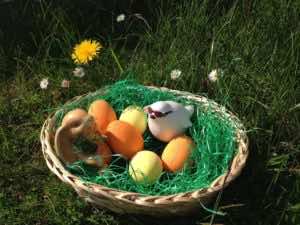Easter Items Poisonous to Your Pet
Easter is just around the corner and many of the décor and treats that we use to celebrate the day can be harmful to your pets! In our 3rd and final installment of Spring Poisons for Your Pet, we talk about the top 4 dangers awaiting your pet this Easter.
 Chocolate & other Easter candy Chocolate & other Easter candy
One of the main things that most people like to fill Easter baskets with is lots of candy and chocolate. Those giant chocolate bunnies and Cadbury chocolate eggs are very popular this time of year, and most of us know that chocolate can be very harmful to our pets. Easter is one of 4 holidays when Pet Poison Hotlines get the most calls about chocolate exposure! Most people might not realize that dark and unsweetened chocolates are the most toxic types of chocolates to pets. Some signs of chocolate exposure are hyperactivity, diarrhea, vomiting, elevated or abnormal heart rates, or even seizures.  Let’s not forget other candies we might include in Easter baskets. If you decide to include sugar-free candies or gum in your baskets, there may be a risk of your pet ingesting Xylitol, a common ingredient in sugar-free prepared items. Xylitol is very toxic to dogs and can result in a drop in blood sugar. Some symptoms of Xylitol ingestion are lethargy, vomiting, weakness, and seizures. If you suspect your pet has ingested any sort of candy with Xylitol or chocolate, make sure you contact your vet or a pet poison hotline immediately! Let’s not forget other candies we might include in Easter baskets. If you decide to include sugar-free candies or gum in your baskets, there may be a risk of your pet ingesting Xylitol, a common ingredient in sugar-free prepared items. Xylitol is very toxic to dogs and can result in a drop in blood sugar. Some symptoms of Xylitol ingestion are lethargy, vomiting, weakness, and seizures. If you suspect your pet has ingested any sort of candy with Xylitol or chocolate, make sure you contact your vet or a pet poison hotline immediately!
|
 Easter FillersOne of the most common fillers for Easter baskets is the stringy Easter grass that comes in various pastel colors! If your pet decides to eat or chew on this material, it can get bunched up in your pet’s intestinal tract or wrapped around organs. If you find your pet with some of this stringy material partially swallowed, DO NOT pull it out! This can damage your pet even further. Plastic eggs can also be very dangerous as little pieces can break off and cut your pet or be swallowed. Also, be aware of any small toys that you might put in Easter baskets. These can be consumed and cause a blockage! |
 Easter Dinner Easter Dinner
When you’re cooking or eating Easter dinner, be aware of some of the foods that might be harmful to your fur babies. If you have Ham, other Pork products, Lamb, or other fatty foods for your primary or side dishes, they can cause stomach upset or even pancreatitis, which can be life-threatening or cause other problems for your pet. Onions, garlic, chives, leeks, and other allium family members are toxic to dogs and cats. Signs of ingestion may take several days to develop but can be very serious! Other table foods that can be toxic are macadamia nuts, grapes, and raisins. Ensure you are keeping these foods away from your pets and if you feed them from the table, be aware of what foods you can feed them. |
 Lilies Lilies
We mentioned this in Part 1 of this series, about Garden Plants, where you can read more about the other types of lilies and plants that can be harmful to pets. Here we will focus on Easter lilies, which is just one variety of lily that is highly toxic to cats. Just a tiny amount of any part of these plants, leaves, stem, pollen, flower, and even the water they are stored in, will cause a problem in your cats! Some ingestion signs are lethargy, vomiting, diarrhea, dehydration, extreme thirst, seizures, and death. It is crucial to act quickly if your cat has ingested lilies!! To alleviate the risk, it is best not to have these plants in the house if you have a cat. |
We all want to celebrate and enjoy this holiday, and one way to ruin it is to have to rush a pet to the emergency clinic! Keep an eye on your pets while you are celebrating Easter. If you are doing an Easter egg hunt in your backyard, maybe keep the family pet inside! When you layout your kids’ Easter baskets, make sure the dog can’t reach them! There are many dangerous items that we might not think of, but education is vital. The Pet Poison Helpline is a great resource to browse what may be toxic and non-toxic to your furry friends. As we have mentioned in previous articles, it is also a good idea to have an Animal Poison Control Center or an Emergency Clinic on your speed dial. And, please DO NOT induce vomiting in your pet unless you have been told to do so by a veterinarian or Animal Poison Control!
Next week we will talk about what you should have in your Pet First Aid kit.
References
Lock, C. ‘10 Easter Dangers for Pets’, PetMD. Available at: https://www.petmd.com/dog/slideshows/10-easter-dangers-pets (Accessed: 4 April 2019)
‘EASTER PET POISONS’, Pet Poison Helpline, Available at: https://www.petpoisonhelpline.com/pet-owners/seasons/easter/ (Accessed: 4 April 2019)
(2017) ‘Top Four Easter Hazards for Pets’, ASPCA, 12 April. Available at: https://www.aspca.org/news/top-four-easter-hazards-pets (Accessed: 4 April 2019)




 Let’s not forget other candies we might include in Easter baskets. If you decide to include sugar-free candies or gum in your baskets, there may be a risk of your pet ingesting Xylitol, a common ingredient in sugar-free prepared items. Xylitol is very toxic to dogs and can result in a drop in blood sugar. Some symptoms of Xylitol ingestion are lethargy, vomiting, weakness, and seizures. If you suspect your pet has ingested any sort of candy with Xylitol or chocolate, make sure you contact your vet or a pet poison hotline immediately!
Let’s not forget other candies we might include in Easter baskets. If you decide to include sugar-free candies or gum in your baskets, there may be a risk of your pet ingesting Xylitol, a common ingredient in sugar-free prepared items. Xylitol is very toxic to dogs and can result in a drop in blood sugar. Some symptoms of Xylitol ingestion are lethargy, vomiting, weakness, and seizures. If you suspect your pet has ingested any sort of candy with Xylitol or chocolate, make sure you contact your vet or a pet poison hotline immediately! Easter Dinner
Easter Dinner Lilies
Lilies